How to Spot a Fake Blue Gem Skin: A Visual Guide
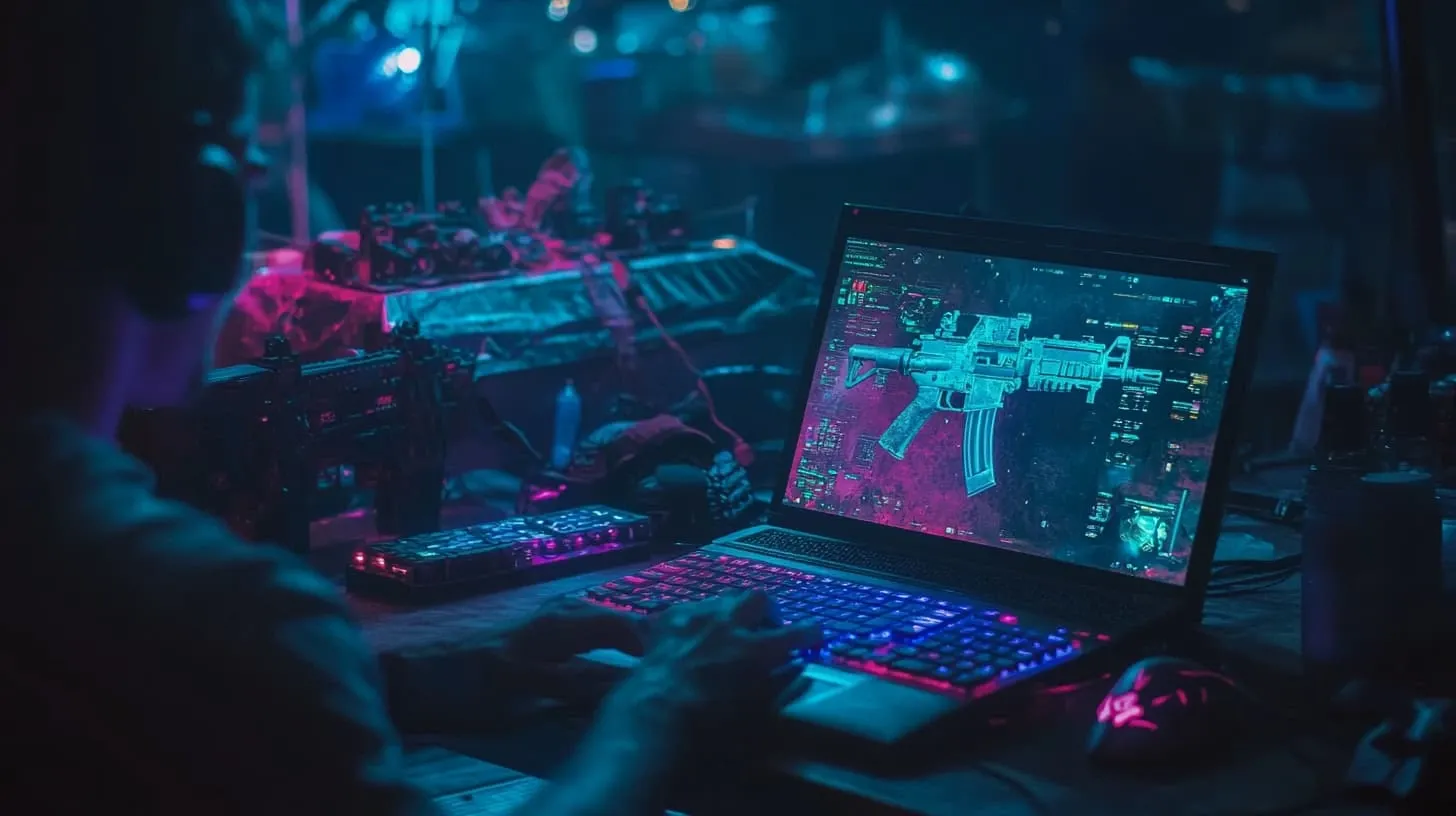
How important is it to check for a fake Blue Gem? Your friend told you Blue Gems cost a fortune, so you snagged a Karambit | Case Hardened covered in blue for $2500 over market.
You thought you scored the deal of the century, but it turns out you ended up losing money.
In today’s CS2 skin landscape, riddled with scams and subtle deceit, even seasoned traders can struggle to tell real Blue Gems from fakes.
When it comes to Blue Gems, prices can range from thousands to even millions. Most of these sales happen off-platform to avoid losing money to fees. And even a small mistake can cost a fortune. That’s why it’s crucial to make sure you’re really getting what you think you are.
That's where we come in, with our Blue Gem skin visual guide that can help you spot genuine patterns and avoid fakes.
What Makes Blue Gem Skins So Valuable?
Blue Gems are easily the most expensive items in Counter-Strike collections. To give you an idea, the #1 pattern Karambit | Case Hardened can fetch anywhere between $1-2 million. But what gives these Blue Gems this incredible value? The simple answer is that their rarity, high demand, and royal look make it a collector’s item.
To understand why these skins are so rare, we first need to look at how their patterns are formed. The Case Hardened pattern comes from a portion of the skin’s texture, which contains colors like blue, gold, and purple scattered in a specific arrangement. Each skin has a pattern template, a number between 1 and 999, that decides which part of the texture covers it. The right seed can give you the pattern with the most blue, while the wrong one… not so much.
Now, let’s see what that looks like in practice with the Karambit | Blue Gem pattern #387. The odds of unboxing it are insane. You first need to get your hands on cases like CS:GO Weapon Case, Operation Bravo Case, Phoenix Case, or others that contain this knife. From that case, the chances of getting the Karambit | Case Hardened pattern #387 is roughly 1 in 357 million, meaning it would take over a billion dollars in case openings to justify it.
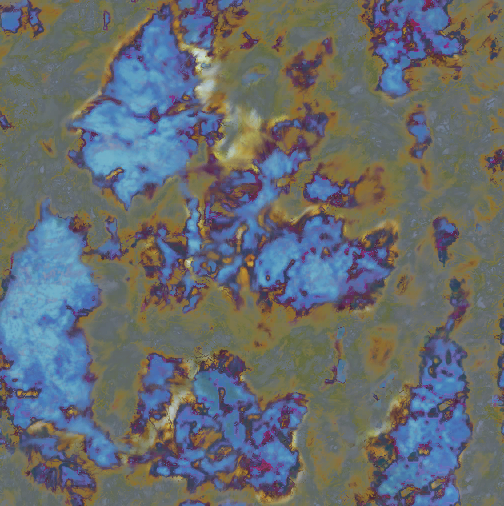
The image showcases the pattern texture of case-hardened skins.
Now you can see why this knife holds such an astronomical price tag. So far, there is only Karambit | Case Hardened Factory New Pattern #387 in existence. And it belongs to Chinese collector 青い王. The AK-47 | Case Hardened pattern #661 is another popular skin among collectors, which is speculated to be worth over $1 million. With such large figures involved, you need to verify the authenticity of the collector and trader before getting into a deal, as Blue Gem scams and CS2 Blue Gem fraud are common in high-value trades.
While the above examples included the top-tier patterns of Blue Gems, Blue Gems actually exist across tiers 1-4, with the amount of blue decreasing at each tier. This makes identifying and estimating their value even more complex. Even a tier-4 Blue Gem can lead to overpaying, which is exactly why scammers target players who aren’t familiar with these skins. That’s also why it’s so important to know how to identify a real Blue Gem.
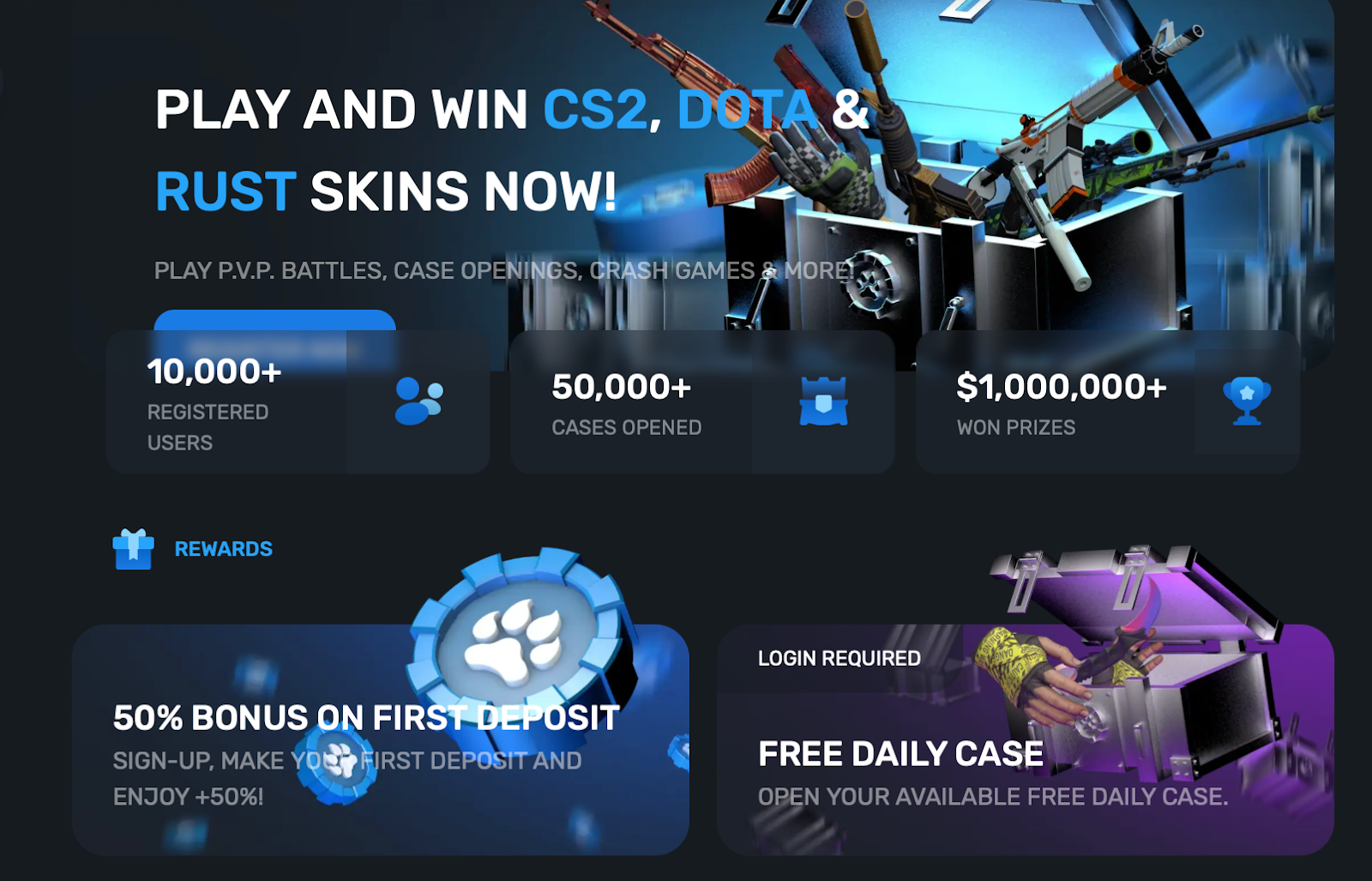
Trusted platforms like SkinsLuck CSGO trading site provide safer environments for getting new skins, including Blue Gem and other high-tier items.
How to Identify a Real vs Fake Blue Gem Skin
Now that you understand the importance of identifying Blue Gems, let us take a look at the checks you need to perform:
- Inspect in-game: When you’re offered a Blue Gem skin, always inspect it on Steam yourself first to confirm that the screenshot belongs to the actual item. You can also check the pattern index and the float of the skin while inspecting in-game.
- Check pattern index/paint seed: You can’t tell if the skin is a tier-1 or tier-2 Blue Gem by simply looking at it. Cross-checking the Pattern indexes with verified databases can help you fetch the exact blue layout and even previous sales.
- Verify float/wear: The Float value determines the skin’s wear and directly affects the price. Don’t just focus on the amount of blue; cross-check the float as well. Even a 0.1 difference in float can substantially change the skin’s value.
- Use inspect links when necessary: If you can’t access your PC, some websites allow you to generate screenshots and view float and paint seeds on your mobile device. This isn’t as reliable as in-game inspection, but it’s a good backup.
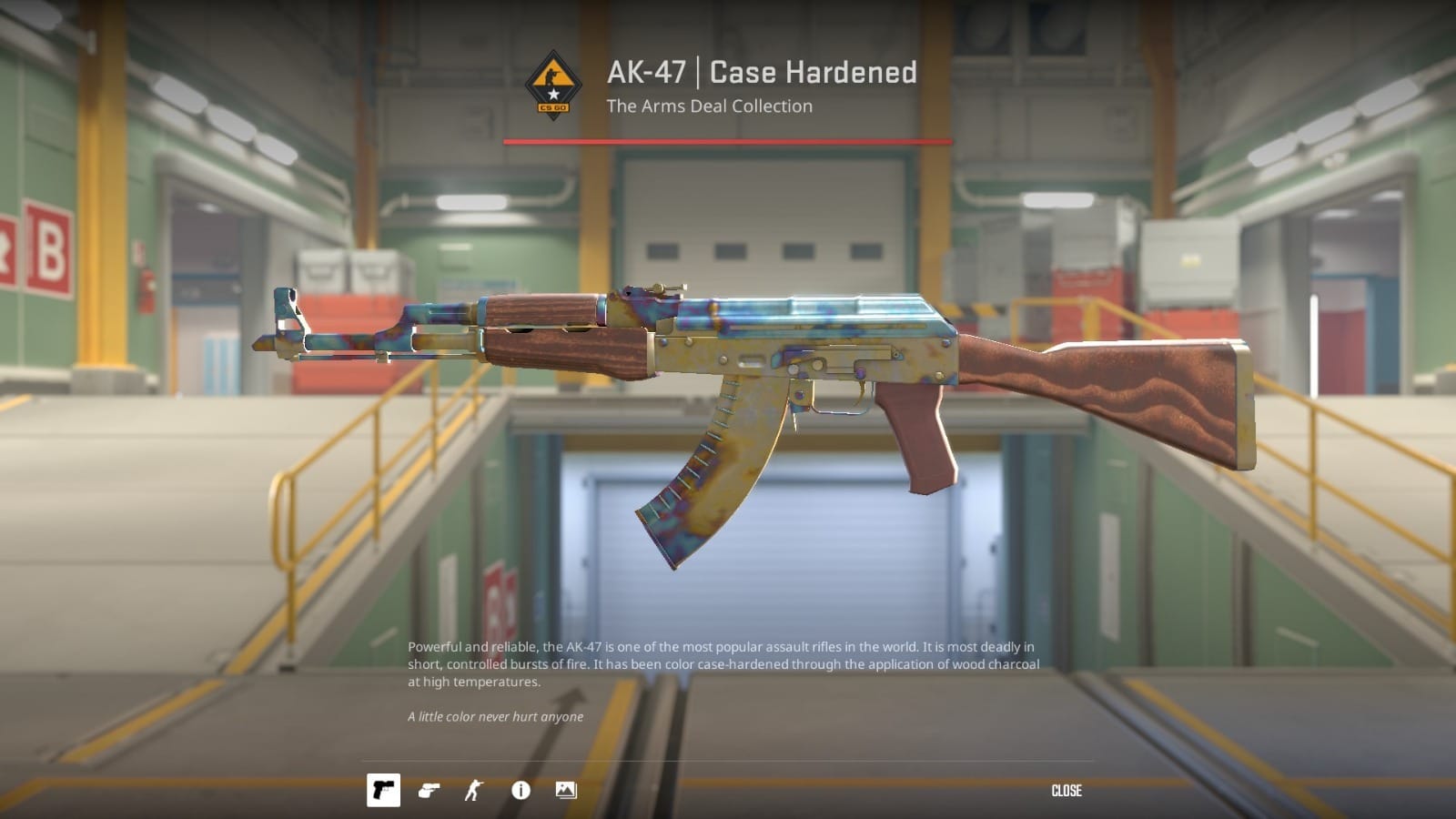
The image above showcases the AK-47 | Case Hardened Pattern #661
- Check the authenticity of the seller: Trading with new, unverified sellers or sellers with private inventories should be a big no. It is always a positive sign if the trader has a public inventory with some high-tier items.
- Price check: Compare the offered price with recent market sales to ensure it’s reasonable. While Blue Gems are hard to price precisely, you can always check the sales on sites like CSFloat or Buff163 to gauge an estimated value.
- Never trust external links: If the seller provides you with an external link to inspect the skin, avoid clicking on it. The safest approach is to visit the seller’s Steam profile yourself and inspect the skin directly in CS2 or the Steam client.
- Cross-reference with verified databases: Use trusted pattern index checkers or community forums to confirm the authenticity of the skins. You can use the CSfloat database to get an idea about how many exist of this kind.
- Check the items in the trade carefully: Make sure the seller is sending the exact knife or skin you agreed on. The best way to do it, is again, to inspect it in-game before accepting. It’s easy to receive a different skin, or even an item from another game entirely, if you aren’t paying attention.
- Look for anomalies in color coverage: If you are working with a screenshot, examine edges, sticker placement, and hue consistency. A blue gem can easily be faked by stickers. And sometimes even a Phase 3 Gamma Doppler Karambit might look like a Blue Gem if you’re not careful.
How to Compare Real vs Fake Blue Gems
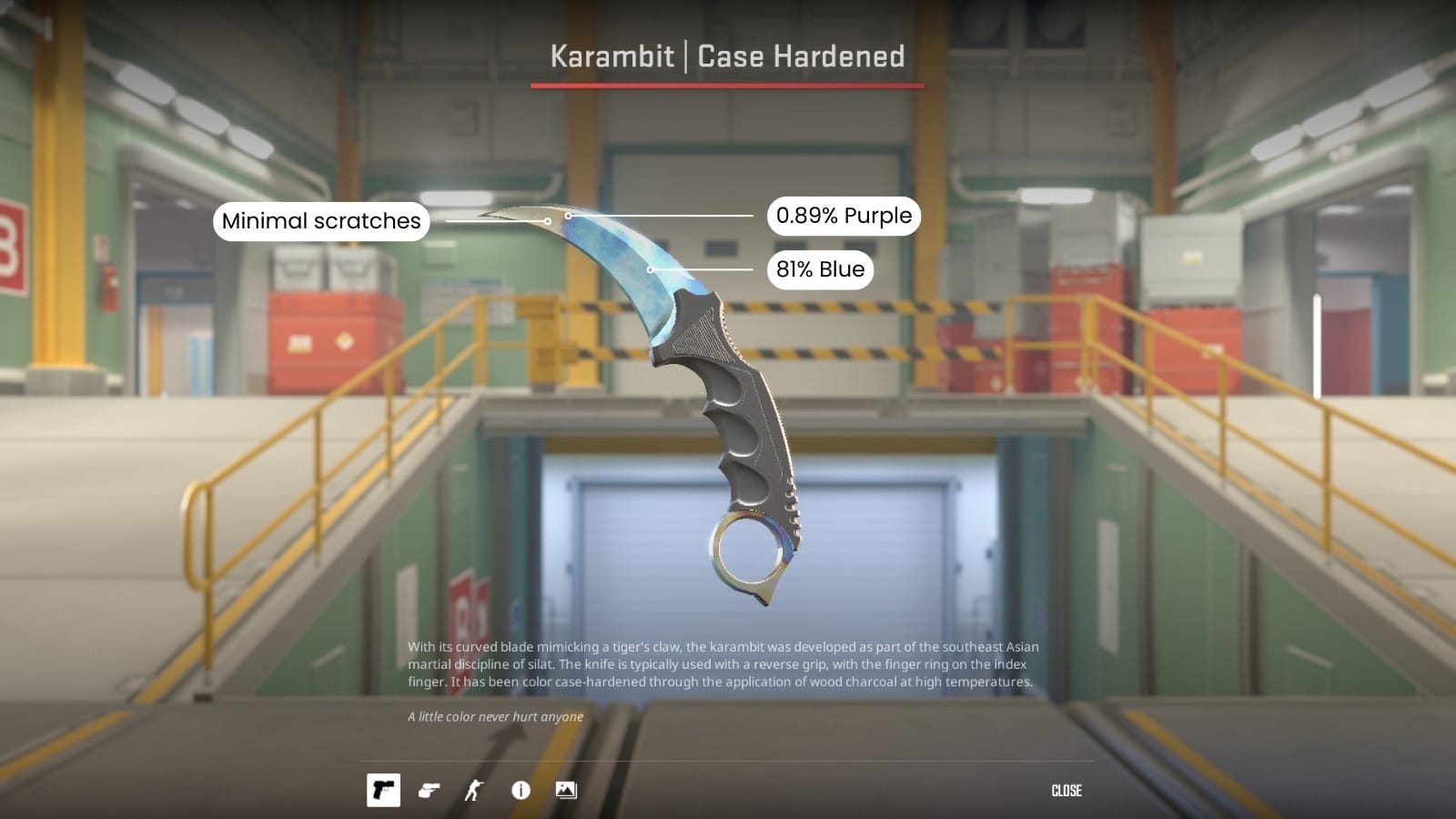
The image above showcases the Pattern 664 (Tier-3 Blue Gem)
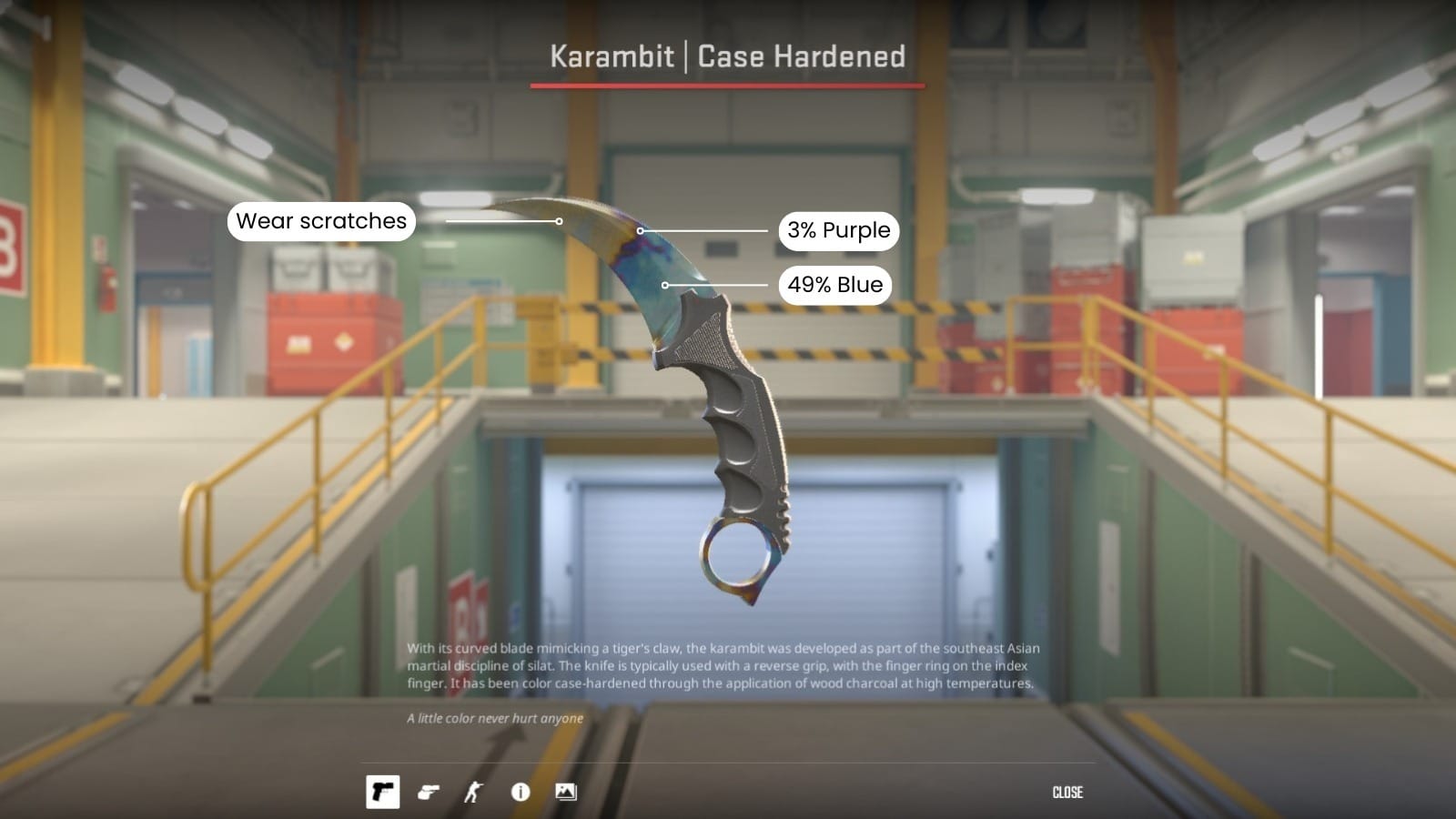
The image above showcases the Pattern 749 (Fake Blue Gem)
When trying to compare a real blue gem vs a fake one, pay close attention to the distribution of blue, purple, and gold across the skin. In the two examples shown above, both display a considerable amount of blue. But the second image shows a larger blue coverage and fewer purple blotches than the first one.
This difference in color balance is often the clearest indicator of how to verify the Blue Gem’s authenticity. It also helps in pointing out the Blue Gem pattern differences. You can compare the screenshot with the database to see whether the pattern has the same amount of blue as the data reflects, to see if it is a real vs fake CS2 skin.
Tools and Methods to Verify Authentic Blue Gems
Steam Inspect: The Steam client itself serves as the best option to verify authentic blue gems. On Steam, you can click on the item and then click on the Inspect in-game button to view float, paint seed, and pattern in-game. It is important to rely only on live inspection to avoid getting fake skins.
Pattern index databases: You should use verified community databases to check the tier of the pattern index. It is an essential tool to verify CS:GO skin authenticity to avoid scams. For example, you can check the patterns for Talon Knife | Case Hardened on our guide on Talon Knife.
Recent Sales: To cross-reference the price of a skin, you can refer to marketplace listings to check listings and sales. Go to the respective marketplace, fill in the necessary filters, and check the sales. It is also important to note the date of sale, as the prices of Blue Gems have been following an upward trend.
Generate Screenshots: There are a plethora of tools you can use to generate screenshots. Most trading sites have a feature to generate screenshots. For example, you can use Skinport’s screenshot tool, which also elicits float, stickers, and pattern templates. You don’t get a 360 view, but you can still draw out a lot of information from the tool.
Community verification channels: Forums or Discord servers with experienced traders can help confirm a skin’s legitimacy. Reputable ones include the likes of CSBlueGem, where you can ask veterans for price checks. But it is important to note that while they can help, don’t take their advice blindly.
⚠️ Warning: Avoid websites claiming to verify skins that ask for Steam login or API keys. These are scams designed to steal accounts. Always stick to official tools and reputable sources.
Mistakes to Avoid When Buying Blue Gem Skins
Here are our expert tips to avoid Blue Gem scams and protect your inventory:
- Avoid unverified sellers. “Always check the seller’s trade history, items in inventory, and profile before committing,” says one of our experts. Accounts with private inventories usually belong to scammers.
- Don’t rely on screenshots alone. Edited images can make a fake Blue Gem appear genuine. Our expert tip: “Use in-game inspection to verify the float, paint seed, and pattern index every time.”
- Check pattern indexes carefully. Knowing the exact pattern numbers is the easiest way to help distinguish a real Blue Gem skin from a fake one. Screenshots can be altered, but verified pattern indexes don’t lie.
Other mistakes include ignoring float values, skipping cross-references with community databases, or trading without confirming the item in the trade window. Even experienced collectors can fall victim to Blue Gem scams if they skip these checks.
Trading Safely in the Marketplace
It is essential to keep your eyes and ears open when trading. Always verify each item in the trade properly. Cross-check the seller’s Steam level and date of joining with the one on the site.
If you suspect a scam:
- Stop the trade.
- Inspect the skin in-game and ask for timestamped screenshots.
- Ask for the whole, trade history of the seller.
- Report suspicious activity to Steam or consult a community moderator.
Remember, scammers often target high-value skins like Blue Gems, so if you own a blue gem, you need to stay vigilant for your defense.
Final Takeaways on Fake Blue Gem Skins
It becomes clear now that you should not trust blindly when dealing with high-value Blue Gems. If the deal is too good to be true, it usually is. Remember, no platform is completely risk-free. You still need to stay vigilant, use your own judgment, and consult trusted community members to avoid financial loss.
It only takes a few minutes, but applying these tips before making a trade can go a long way in helping you avoid falling for Blue Gem scams and ensure you’re buying genuine, high-value items. Even if you are a seasoned trader, these few cross-checks can save you thousands or even millions of dollars.
FAQ – Spotting Fake Blue Gem Skins
How can I tell if a Blue Gem skin is fake?
The most reliable way to tell a fake is to inspect it in-game. While inspecting, check the pattern index and float value. Then, compare the data against verified databases, and look for its sales to get an accurate value.
Are all marketplaces reliable?
Not all marketplaces are reliable. Trusted platforms like SkinsLuck or verified Steam listings are safer, but most of the high-tier Blue Gem trades happen off-platform. It is thus advisable to cross-check the seller’s reputation, trade history, and the skin’s details before committing.
Can pattern indexes be trusted?
Pattern indexes are useful but can’t be trusted blindly. It is easy to manipulate screenshots or photos. To make sure you are not falling for a lousy scam, verify the indexes in-game or through a known website to ensure that they match the actual skin.
What’s the most common scam for Blue Gem skins?
The most common scam involves selling fake Blue Gems using doctored screenshots or photos. Some sellers may also send a different skin in trades. High-value trades are especially targeted.
Can photos of Blue Gems be faked?
Absolutely. It’s easy to alter images or clone parts of a skin to make it look more “blue.” You should never rely solely on screenshots. To avoid falling for Blue Gem scams, inspect the skin in-game yourself.
